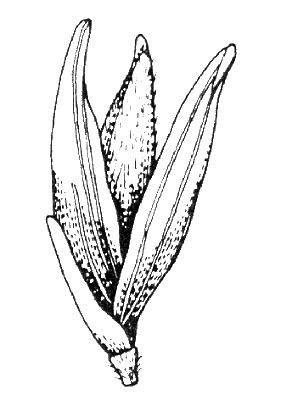Entolasia whiteana C. E. Hubbard. Hooker's Icon. Pl. t. 3338 (1937).
Classification. (GPWG 2001) : Subfamily Panicoideae. Paniceae.
Type of Basionym or
Protologue Information: Queensland:
Bulimba: Brisbane,
abundant on dry barren rocky slopes, cleared Eucalyptus forest country, Sep
1930, Hubbard 4079.
Key references
(books and floras): [2002] D.Sharp & B.K.Simon, AusGrass, Grasses of
Australia,
[2008] S.W.L.Jacobs, R.D.B.Walley & D.J.B.Wheeler, Grasses of New South
Wales (245).
Illustrations:
[2008] S.W.L.Jacobs, R.D.B.Whalley & D.J.B.Wheeler, Grasses of New South
Wales, 4th edn (245).
Habit.
Perennial. Rhizomes present, short. Culms erect or geniculately ascending,
20–80 cm tall, wiry, 4–9 -noded. Mid-culm internodes hollow, glabrous or
hirsute. Leaf-sheaths hairy. Ligule a fringe of hairs, 0.6–1.2 mm long.
Leaf-blades involute, 1–10 cm long, 1–5 mm wide. Leaf-blade surface smooth,
glabrous or indumented.
Inflorescence.
Inflorescence compound, a panicle of racemes. Racemes 2–9, erect, 1–3 cm long,
bearing 2–14 fertile spikelets on each. Central inflorescence axis 2–12 cm
long.
Spikelets. Spikelets
pedicelled. Fertile spikelets 2-flowered, the lower floret barren (rarely
male), the upper fertile, comprising 1 basal sterile florets, comprising 1
fertile floret(s), without rachilla extension, lanceolate or elliptic, dorsally
compressed, 4–6 mm long.
Glumes. Glumes
dissimilar, thinner than fertile lemma. Lower glume ovate, membranous, without
keels, 0–3 -nerved. Upper glume lanceolate or elliptic, 3.8–6 mm long,
herbaceous, without keels, 5 -nerved. Upper glume surface smooth or asperulous.
Upper glume apex muticous. Florets. Basal sterile florets 1, barren,
without significant palea. Lemma of lower sterile floret 100 % of length of
spikelet, herbaceous, 5 -nerved.
Fertile lemma 3.5–5.5
mm long, without keel, 5 -nerved. Lemma surface indumented. Palea 2 -nerved.
Grain 2.5–3 mm long.
Continental
Distribution: Australasia.
Australian
Distribution: Queensland, New South Wales.
Queensland:
Cook, Leichhardt, Moreton, Wide
Bay, South Kennedy. New South Wales: North
Coast, Central Coast.
Notes.
Few collections of this taxon have been made. It resembles E. stricta
but can be distinguished on spikelet length, and, at first sight, can be
confused with Cleistochloa rigida.
In tropical and
subtropical wet sclerophyll forests, temperate wet sclerophyll forests, dry
sclerophyll forests, Brigalow forests, tropical and subtropical sub-humid
woodlands, temperate sub-humid woodlands, and semi-arid shrub woodlands.
Inhabits sandstone ridges in open Eucalyptus forests. Flowers
sporadically throughout the year.
Similar to E. stricta by having incurved to involute leaf blades, whereas E. marginata and E. minutifolia have leaf blades that are flat; the upper lemma is longer than in these species. It differs from E. stricta by having longer spikelets. It is similar vegetatively with Cleistochloa rigida.



